Alternate Interior Angles
The pair of non-adjacent angles that lie between the two lines but are on opposite sides of the transversal are called alternate interior angles.
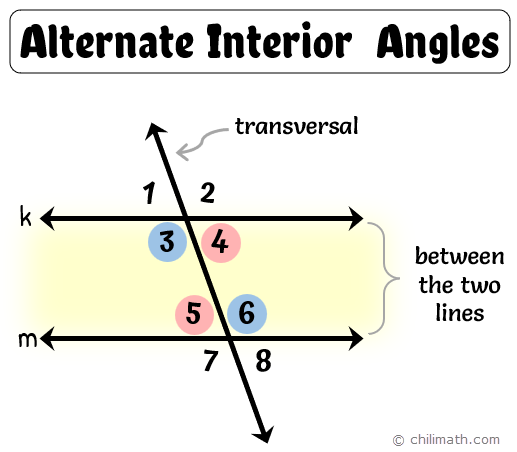
Alternate interior angles are formed when a transversal crosses two parallel or non-parallel lines. One way to help you identify this angle pair is to look closely at the words alternate and interior.
Alternate tells you that the angles lie on opposite sides of the transversal. Interior, on the other hand, means that the angles lie on the inner side of the two lines.
In our diagram above, both [latex]\angle 3[/latex] and [latex]\angle 6[/latex] are located on the inner side or in between the lines [latex]k[/latex] and [latex]m[/latex]. They are also on opposite sides of the transversal and are not adjacent to each other. Hence, [latex]\angle 3[/latex] and [latex]\angle 6[/latex] are a pair of alternate interior angles. The other pair is [latex]\angle 5[/latex] and [latex]\angle 4[/latex].
TIP: You can easily spot a pair of alternate interior angles because they form a Z-shape or a backward Z-shape as you can see in the illustrations below.
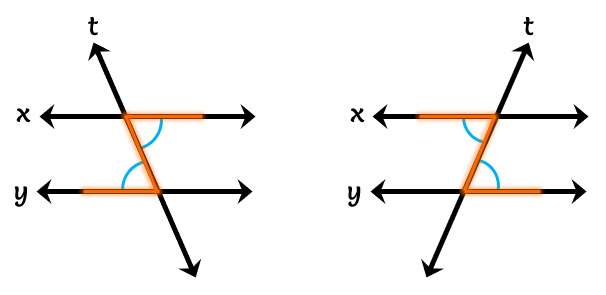
Alternate Interior Angles Theorem
If two parallel lines are cut by a transversal, then the pairs of alternate interior angles are congruent.
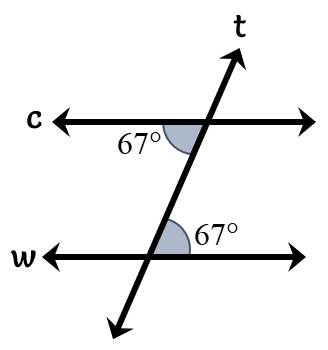
Here we have the transversal, [latex]t[/latex], intersecting lines [latex]c[/latex] and [latex]w[/latex]. Since alternate interior angles are congruent, both angles have the same measure.
However, if a transversal cuts through two non-parallel lines, the pairs of alternate interior angles formed are not congruent and have no relationship in any way.
Example Problems Involving Alternate Interior Angles
Example 1: List all pairs of alternate interior angles.
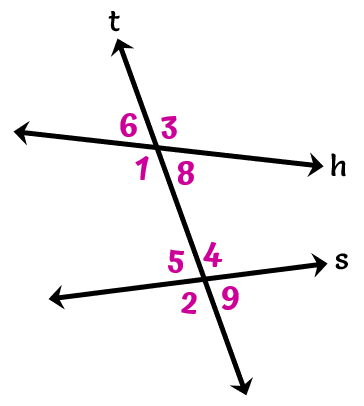
Right off the bat, we can see that [latex]\angle 1[/latex], [latex]\angle 8[/latex], [latex]\angle 5[/latex], and [latex]\angle 4[/latex] are located on the inner side of our two lines, lines [latex]h[/latex] and [latex]s[/latex]. They are our interior angles.
But since we are asked to identify the pairs of alternate interior angles, let’s look at the pairs of interior angles that are non-adjacent and are on opposite sides of the transversal, [latex]t[/latex]. So we have,
- [latex]\angle 1[/latex] and [latex]\angle 4[/latex]
- [latex]\angle 8[/latex] and [latex]\angle 5[/latex]
Example 2: Fill in the blanks to make the following statements true.
- When a transversal intersects two ___________ lines, the alternate interior angles formed are congruent.
- If two non-parallel lines are cut by a transversal, then the alternate interior angles are _____________.
Answers:
When a transversal intersects two parallel lines, the alternate interior angles formed are congruent.
If two non-parallel lines are cut by a transversal, then the alternate interior angles are not congruent.
Example 3: If [latex]\angle 6[/latex] measures [latex]54^\circ [/latex], what is the measure of [latex]\angle 3[/latex]?
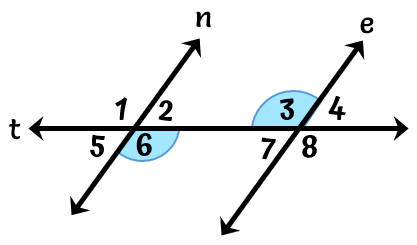
When asked to determine angle measures, it’s always a good habit to first identify the special relationship of the angles given. In this example, we are provided the measurement of [latex]\angle 6[/latex] and then asked what the measure of [latex]\angle 3[/latex] is. Both angles lie between lines [latex]n[/latex] and [latex]e[/latex] which instantly makes them interior angles. Then we see that they are located on opposite sides of the transversal. Therefore, [latex]\angle 6[/latex] and [latex]\angle 3[/latex] are alternate interior angles.
Next, recall that when two parallel lines are cut by a transversal, then alternate interior angles are congruent. So this means that [latex]\angle 6[/latex] and [latex]\angle 3[/latex] are congruent or have equal measure.
Since the measure of [latex]\angle 6[/latex] is [latex]54^\circ [/latex], then [latex]\angle \textbf{3}[/latex] also measures [latex]\textbf{54}^\circ [/latex].
You may also be interested in these related math lessons or tutorials:
